Use 'Print preview' to check the number of pages and printer settings.
Print functionality varies between browsers.
Printable page generated Thursday, 25 April 2024, 10:21 AM
Study Session 9 Influencing Behaviour
Introduction
Once you have identified the determinants of a behaviour that you want to change (Study Session 8), it is time to think about how you might influence the desired behaviour by developing a behaviour change strategy. You may encounter both barriers and motivators relating to cost, availability, service delivery, interaction with communities, channels of communication, or the content or clarity of the messages about change.
There are several reinforcing approaches to communication that aims to influence behaviour – the main ones are behaviour change communication, social change communication, social mobilisation, and advocacy. A WASH communication programme may include all these approaches to increase and sustain demand, acceptance and utilisation of various services.
This study session introduces these major communication approaches to influencing behaviour, which are described in more detail in following study sessions. It also describes the main steps for organising and implementing a successful WASH campaign.
Learning Outcomes for Study Session 9
When you have studied this session, you should be able to:
9.1 Define and use correctly all of the key words printed in bold. (SAQs 9.1 and 9.2)
9.2 Develop a simple behaviour change strategy. (SAQ 9.1)
9.3 Explain key communication approaches related to hygiene and sanitation promotion. (SAQs 9.2 and 9.3)
9.4 Describe the processes involved in conducting WASH campaigns. (SAQs 9.3 and 9.4)
9.1 Developing a behaviour change strategy
Once you have completed your analysis of a behaviour, using the tools we explored in Study Session 8, you are ready to design the strategy that can be used to bring about the desired behaviour change. Having a thorough understanding of the current situation is critically important here. Consider the following case study.
Case Study 9.1 The importance of linking information and strategy
Tedlar is a health promotion worker who has been tasked with getting mothers in his community to wash their hands before cooking food. Tedlar thinks that the women don’t understand the health risks of not washing their hands and spends nearly all his budget on a big promotion campaign with leaflets and radio messaging. Three months into the campaign he conducts a survey and finds that there has been minimal progress in achieving the desired behaviour.
Tedlar realises he has relied on his own beliefs and needs a more objective understanding of the situation. He conducts a situation analysis and barrier analysis to inform a FOAM framework describing the existing situation. At this point he discovers that the women are aware of the health risks but not driven by this knowledge. The reasons for handwashing that are important to them are disgust at dirty hands, nurture of their children, and the critical opinions of other women. These are much stronger determinants in this context. He also finds that some of the women have no access to handwashing facilities, so no amount of desire to wash is going to help them with the practical activity. Those that do have access and good intentions still need frequent reminding to change their habits.
Tedlar now needs to develop a behaviour change strategy that focuses on providing the missing facilities and the facilitating determinants through appropriate communication and support. (Remember from Study Session 8 that determinants can be facilitating (helpful and encouraging) or deterrents (barriers) to desirable behaviour.)
What Tedlar was missing was a clear and well-designed behaviour change strategy that set out how resources are allocated and how he should plan his time in order to be most effective. Behaviour change strategies should focus on maximising the facilitating determinants of a behaviour and minimising the deterrents.
A behaviour change strategy should therefore be driven by the information you gathered in your framework analysis. It should include:
- the goal that you want to achieve
- the activities that you will need to complete in order to achieve that goal
- the resources you will need to support those activities (e.g. money, people, products, facilities, licenses, approvals, etc.)
- the schedule for the activities
- the means by which you will evaluate the effectiveness of the programme.
Arguably the most important thread in your behaviour change strategy is communication, the process by which information is exchanged between individuals or groups. Effective communication takes place when all parties in the exchange understand the information in the same way.
9.2 Channels for communication
Communication can take place through a wide variety of means or channels including interpersonal, group, community, and mass and social media communication channels. If you are planning behaviour change communication or social change communication you should assess all possible ways and means to get your message across. For example, consider what might be the most appropriate channels to promote handwashing with soap in primary schools in your woreda. You will need to consider:
- Are there WASH clubs in the schools?
- Would posters be effective?
- Do the schools have radios?
- Do the schools have television sets?
- Do the schools have computers? With or without internet access?
- Which of these communication channels do students prefer?
- Which channel do they trust?
Some methods of transmitting information to children are illustrated in Figures 9.1 and 9.2.


It is critical to select the channels that will be most appropriate for reaching the school children frequently and effectively. You should take the following points into consideration.
- Different channels play different roles. Using several channels at the same time increases the impact of communication messages. For example, you can use school clubs to promote handwashing with soap but, with the cooperation of teachers, you can also use peer education sessions where children learn with and from each other, as shown in Figure 9.3, or recorded audio messages to reinforce the message.
- Select channels that are accessible and appropriate. For example, printed written materials should be distributed only to literate participants but materials based on pictures can be used to communicate with almost anyone.
- The effectiveness of a channel can be measured by its ability to get people to understand and remember information, to be motivated to tell other people about this information, and to change their behaviour based on the information. A channel could also be considered effective if it provides timely information, creates an appropriate climate for change, efficiently reaches targeted groups of people, and is cost-effective.

Your behaviour change strategy will depend on effective communication with your target group. The following sections of this study session look at the main approaches to communicating about changing WASH behaviour. These approaches are (UNICEF, 2005):
- behaviour change communication, which is about influencing individuals
- social change communication and social mobilisation, which are about influencing communities and other groups
- advocacy, which is about influencing decision makers at all levels.
9.3 Behaviour change communication
In the context of WASH initiatives, behaviour change communication is communication that is intended to help individuals change their behaviour so that they develop more healthy practices. It attempts to bridge the gap between factual information, a person's knowledge and attitudes, and their subsequent behaviour.
This approach addresses the knowledge, attitudes, practices and skills of individuals as they relate to specific WASH programme goals. Targeted individuals gain more accurate knowledge, and hence change or develop attitudes and skills that will motivate them to develop more positive, healthy and protective practices. Now read Case Study 9.2 and answer the questions that follow.
Case Study 9.2 Child marriage and its reduction
In a rural woreda, there had been frequent occurrences of child marriage. This continued for many reasons, but the central issues were that the local authorities did not consider child marriage a problem and there were no punitive measures towards the perpetrators.
In an effort to reverse these trends, a behaviour change strategy was developed to convince local level decision makers to take action. They were encouraged to establish ‘action committees’ and force parents to get permission from the kebeleadministration before they could arrange a wedding for their daughters. The kebeleadministration issues permission for the marriage only after making sure, through testimonies of witnesses,that the bride is at least 18 years of age. The establishment of the ‘action committees’ have resulted in girls having somewhere to go for support and advice when their rights are violated. In addition, community conversations (Figure 9.4) were conducted in the communities to empower them to draw up bylaws to stop the child marriage practice. Religious leaders, women’s associations and youth groups were brought on board to create awareness of the issues involved.
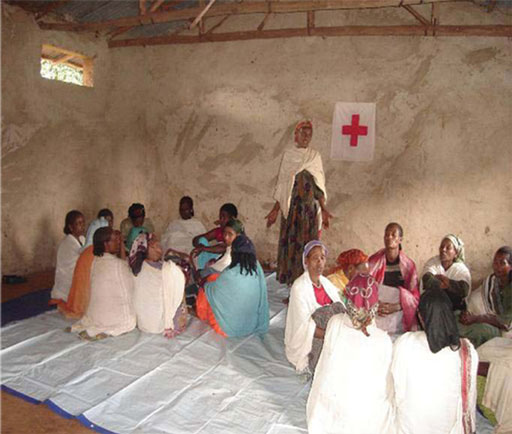
Because of all these interventions, there has been a noticeable reduction in incidences of child marriage. Young girls in the woreda are now less likely to drop out of school to marry, as no man can marry a woman without written approval of the kebele administration. In addition, counselling sessions have been introduced in the primary school, and students are encouraged to discuss child marriage and girls' education as part of Girls' Forum and Girls' Club activities. Such a session is shown in Figure 9.5.
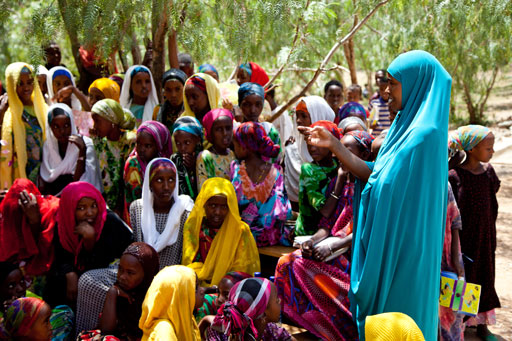
The two main reasons why child marriage continued to be practised were that the local authorities did not consider it to be a problem and it was not punished. Which of the subgroups of behavioural determinants in the FOAM framework are demonstrated by these reasons?
The first indicates that the local authorities were not motivated to change because of their attitudes to child marriage and their values. Child marriage was also a social norm in this community. The lack of punishment shows how sanctions and enforcement can influence behaviour.
Identify two individual behaviour changes that helped to reduce child marriage in this case study.
The answer is as follows:
- Parents were helped to understand the negative effects of child marriage.
- Parents were encouraged to seek permission of the kebele administration before arranging marriages.
Behaviour change communication is concerned with influencing the behaviour of individuals. Individuals are highly influenced by factors in the environment around them, such as gender, power and culture, as well as by the organisation of their local community and the political and economic environment. This is explained in Section 9.4.
9.4 Social change communication and social mobilisation
Some theories of behaviour change move away from the individual and focus more on the relationships between behaviour and the social and physical environments in which it occurs. Individuals are dependent on their environment and the structure of the systems in which they live. This means that they are influenced by the organisational, political and economic environment and also by gender, power, culture and community issues.
If you were undertaking an assessment of behaviour, you will identify any relevant values and social norms as behaviour determinants when completing the FOAM framework. If they were significant factors, as in the case study above, then a social change communication approach could be a useful tool in your behaviour change strategy. Social change communication focuses on the community as the unit of change rather than the individual. It is a process whereby ‘community dialogue’ and ‘collective action’ work together to produce social change in a community. This can mean changes in people’s understanding of an issue, in their behaviour and practices, in policies, and in gender norms and relations.
The aim of social change in the WASH context is to improve the health and welfare of all members of the community. A response to social change communication might come in the form of social mobilisation, where people in the community come together to act for change. (Community mobilisation is the topic of Study Session 11.)
Community-led total sanitation (CLTS) is one of the social change approaches that helps rural communities to understand the negative effects of poor sanitation and encourages them to take action to eliminate the practice of open defecation. It is an approach that focuses on the community as a whole rather than on individuals. (You will learn more about CLTS in Study Session 10.)
Look back at Case Study 9.2 and identify the social change communication intervention which was used to draw up bylaws to reduce child marriage.
Community conversation were used here to involve the community in drawing up the new bylaws. You might also have mentioned the counselling sessions that took place at the primary school.
9.5 Advocacy
Advocacy means making a case in support of a particular cause or activity and trying to convince other people that it is a good idea. It is a process of gathering and organising information to be communicated to decision makers in an attempt to influence decisions.
Advocacy aims to influence decision makers at various levels – at federal, regional, woreda and local levels. Advocacy for WASH may, for example, try to raise funds and other resources or get support for a particular project from political and social leaders.
You will learn more about advocacy for urban WASH in Study Session 12.
Consider the following approaches that a WASH worker might use to promote improved hygiene and sanitation in their communities. Which of the four communication approaches explained in Sections 9.2 to 9.5 is involved in each case?
- a.Moving from house to house and counselling household members to give advice on hygiene and sanitation issues.
- b.Discussing the importance of hygiene and sanitation with community and religious leaders and encouraging them to provide support in helping communities to improve their practice.
- c.Facilitating dialogue by setting up community discussion groups to talk about sanitation issues.
- d.Coordinating support from local groups such as women’s groups or youth associations, to encourage improvements to hygiene and sanitation practises.
The answers are as follows:
- a.This is an example of behaviour change communication, because it is an attempt to help individual people change their behaviour so that they develop more healthy practices.
- b.This is an example of conducting advocacy, because it is done in an attempt to influence the views and decisions of decision makers themselves.
- c.This is an example of social change communication, because it focuses on community dialogue and action.
- d.This is an example of social mobilisation because it brings together community members to strengthen wider participation and a feeling of ownership of the initiatives to improve hygiene and sanitation.
9.6 Organising WASH campaigns
A campaign is an organised effort that seeks to influence a decision-making process and is generally appropriate when there is a need to raise awareness of an issue within a particular group. Health communication campaigns apply strategies intended to deliver messages designed to influence health behaviours of target audiences. Messages are communicated, either directly or indirectly, through various channels such as:
- mass media (e.g. television, radio, billboards)
- small media (e.g. brochures, leaflets, posters)
- social media (e.g. Facebook, Twitter, blogs, chat rooms, as shown in Figure 9.6)
- interpersonal communication (e.g. one-to-one or group face-to-face education).

The ten important steps needed to conduct an effective hygiene and sanitation campaign are as follows.
Step 1: Analysing the situation
This is covered by the material you studied in Study Session 8.
Step 2: Defining the target audience
This may be any one or more groups from the primary, secondary or tertiary target populations that you identified in the FOAM framework.
Step 3: Identifying objectives
Identifying objectives is a key starting point when planning a hygiene and sanitation campaign. You should consider your objectives in terms of what needs to change. It may be knowledge, attitudes or practices and it is important to identify and describe specific objectives which can be measured, to help you to identify how the effectiveness of the campaign will be ascertained.
Step 4: Designing the campaign
After the objectives have been identified, the campaign strategy should be defined. This includes deciding upon the type of campaign (for example media-based only or an integrated campaign using several communication channels) and its scale (national, regional or local). When you plan the activities of the campaign, you will need to match the behaviour change campaign activities to the determinants that have been identified in the FOAM framework.
Step 5: Selecting media
Once you have defined the design for an appropriate hygiene and sanitation campaign, careful selection of the right communication media is a critical next step. There are four important factors to consider in selecting the most appropriate campaign media:
- How closely your target audience fits the audience profile of the different media.
- The comparative costs of reaching the target audience through different media.
- The time taken for messages to reach the target audience using the different media and whether this matches the timing of your campaign.
- The appropriateness of the different media for the communication of your message.
Step 6: Planning campaign timing
Timing is crucial. You must create a realistic schedule. Estimate the time required for the campaign and decide how long it will take and use this estimate to decide when your campaign should start.
Step 7: Deciding on frequency required for messages
Campaign messages raise levels of awareness each time they are communicated. They also move individuals further along the decision-making process and can serve to maintain contact during an extended process. Campaigns should use repetition to reinforce the impact of their message, and also provide an opportunity to communicate multiple or complex messages about hygiene and sanitation.
Advertising frequency is often decided by the type of media. For example, meetings can be held weekly, print messages can be released daily, public loud hailer announcements can work twice daily, and radio or television commercials can be broadcast many times during the same day.
Step 8: Setting a budget
There are various costs associated with a campaign and you must plan a careful budget to accommodate them. A campaign budget will include both direct and indirect costs. Direct costs include the costs of designing, writing and producing materials and media costs. Indirect costs can include of the cost of activities such as planning, managing and evaluating the campaign.
Step 9: Delivering the messages
Once the decisions have been made about the appropriate communication channel and the design of the campaign, the campaign messages should be delivered. Messages should be clear and – most importantly – few in number. Try to identify one key message for a campaign with two or three supporting messages that reinforce the central point. Ensure that messages are appropriate for the audience and do not be tempted to ‘say everything’. The message should also be presented to audiences at an appropriate time for the audience to receive, consider and act on the messages.
Messages can be delivered using many communication channels including public announcements, written materials (Figure 9.7), radio and TV broadcasts, and community meetings and discussions, which can take place in many locations including meeting places, market places, churches and mosques (Figures 9.8 and 9.9).
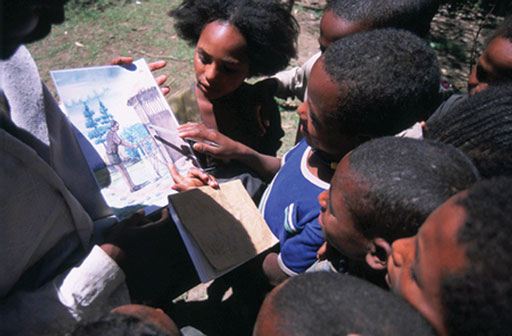
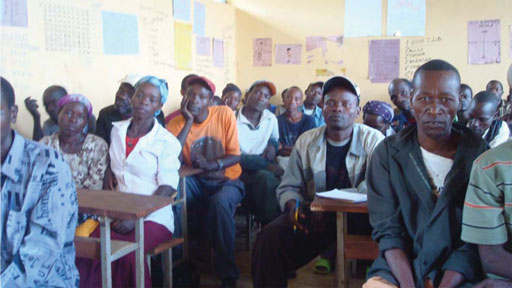
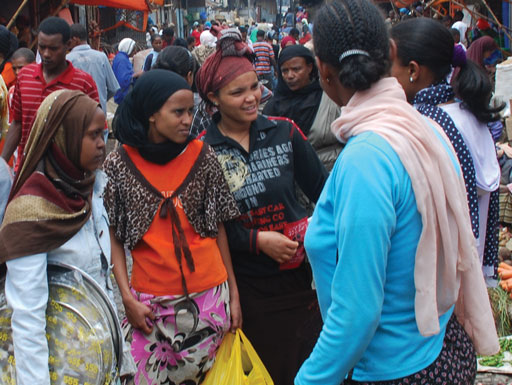
Step 10: Evaluating the campaign
Finally the campaign should be evaluated. The evaluation report ends the campaign process. It is what justifies the work and money spent on the campaign by those who provided the finance, the policymakers, authorities, partners, stakeholders and the campaign team. The final report should provide an overview of each step carried out in preparing and conducting the campaign and its supportive activities. It needs to include an explanation of the rationale for the campaign, the campaign’s basic design, including campaign strategy, how the messages were developed, the communication channel used, and the frequency and intensity at which they were presented.
The evaluation report should end with a discussion and a final conclusion about the strengths and/or weaknesses of the campaign, and its effectiveness.
Summary of Study Session 9
In Study Session 9, you have learned that:
- A behaviour change strategy helps set out a plan for achieving a desired change in health behaviours.
- Behaviour change communication is an approach that addresses the knowledge, attitudes, practices and skills of individuals as they relate to specific WASH programme goals.
- Social change communication is an approach that focuses on changes in community behaviour.
- Social mobilisation is the process of communities acting together towards a shared goal.
- Advocacy is a communication approach used to influence decision makers at all levels, for example to influence their decisions about raising resources or to gain political commitment for a hygiene and sanitation initiative.
- A campaign is an organised effort that seeks to influence a decision-making process and is generally appropriate when there is a need to raise awareness of an issue within a particular group. Health communication campaigns apply strategies intended to deliver messages which are designed to influence health behaviours of target audiences.
Self-Assessment Questions (SAQs) for Study Session 9
Now that you have completed this study session, you can assess how well you have achieved its Learning Outcomes by answering these questions.
SAQ 9.1 (tests Learning Outcomes 9.1 and 9.2)
Imagine that an outbreak of acute watery diarrhoea (AWD) has occurred in a community where you are working. You have identified that most people who are ill, and/or their families, have attended the same community centre building. A FOAM analysis has found that:
- there is only one latrine at the centre and people say that it is always smelly and dirty
- women particularly do not like using the latrine
- there are no functioning handwashing facilities near the latrine
- people do not understand the link between poor hygiene at the centre and their AWD
- the manager of the community centre wanted to build a new latrine block and has identified materials and skilled labour to do so, but has run out of budget for improvements/repairs in the current financial year.
Complete the table below to outline a possible behaviour change strategy that would stop the outbreak. Describe the steps in bullet points rather than detail.
| Goal |
|
| Activities |
|
| Resources |
|
| Schedule | In one week: In one month: In three months: |
| Evaluation |
|
Answer
You probably did not include all these points, but your behaviour change strategy should look something like this:
| Goal | To stop the current outbreak of AWD that originates from [insert name] Community Centre |
| Activities | Repair/clean existing latrine facilities to make it pleasant to use. Repair handwashing facilities close to the latrine. Work with centre manager to conduct behaviour change communication to make sure people understand the importance of washing hands after using the latrine. Identify/allocate/raise funds to build additional latrine facilities, complete with sufficient handwashing stations, so that there are separate latrines for men and women with appropriate facilities – this might need to include a communication strategy for raising funds. Build additional latrine facilities and conduct awareness campaign. Review and evaluate effectiveness of programme. |
| Resources | Two people for one day to clean and paint latrine and repair handwashing station (semi-skilled). Cleaning materials, paint etc. and any parts needed to repair handwashing station. Funds to build additional latrine facilities, if available from existing budget, or one person for six days over four weeks to raise funds from identified sources. Printing, paper and other sundries for communications. One person (you?) for 16 days over three months to oversee and manage behaviour change. Materials and labour for additional latrine facilities. |
| Schedule | In one week: repair, clean and paint latrine, repair handwashing facilities, begin behaviour change communication, begin fundraising activity. In one month: continue behaviour change communication, raise funds, continue behaviour change communication. In three months: additional latrine facilities built and in use. |
| Evaluation | Activities completed according to schedule. People understand importance of handwashing and link to health (conduct survey with community centre users). Number of new cases of AWD declines and becomes zero by week four. |
SAQ 9.2 (tests Learning Outcomes 9.1 and 9.3)
What would be the most appropriate communication approach to use for each of the following scenarios?
- The woreda administration is not allotting sufficient budget for hygiene and sanitation promotion.
- Mothers do not have a sound knowledge of the transmission methods of childhood diarrhoea.
- Open defecation is common practice in your locality.
- NGOs, youth and women associations, and religious institutions are not currently involved in hygiene and sanitation campaigns.
Answer
- Advocacy is an appropriate approach to use to convince decision makers.
- Through behaviour change communication (BCC) it may be possible to increase awareness of how diarrhoea is transmitted, and to change individual behaviour in order to prevent this transmission.
- Social change communication is an appropriate approach to use to promote collective actions at community level to eliminate open defecation.
- Social mobilisation helps you bring together all stakeholders and partners (including NGOs, youth and women associations, and religious institutions) to take action on problems which affect the whole community.
SAQ 9.3 (tests Learning Outcomes 9.3 and 9.4)
What would be the most appropriate communication channel or channels to use for the campaign to prevent the AWD outbreak mentioned in SAQ 9.1 from spreading?
Answer
Many different communication channels might be appropriate, and it would be better to use more than one of these. Interpersonal communication (e.g. meetings and conversations) would be most appropriate and it would be a good idea to reinforce this using small media (e.g. posters, leaflets), social media (e.g. Facebook, Twitter) and mass media (e.g. radio and television) if possible.
SAQ 9.4 (tests Learning Outcome 9.4)
Rearrange these steps in a WASH campaign so they are in the right order:
- Evaluate the campaign.
- Deliver the messages.
- Plan the timing and schedule for your campaign messages.
- Identify the target audience and your objectives.
- Design the campaign and select the media you want to use.
- Set the budget.
- Analyse the situation.
Answer
The correct order is:
- Analyse the situation.
- Identify the target audience and your objectives.
- Design the campaign and select the media you want to use.
- Plan the timing and schedule for your campaign messages.
- Set the budget.
- Deliver the messages.
- Evaluate the campaign.